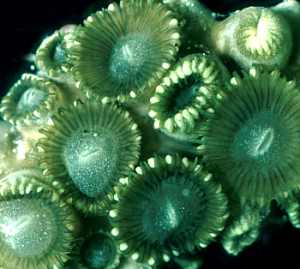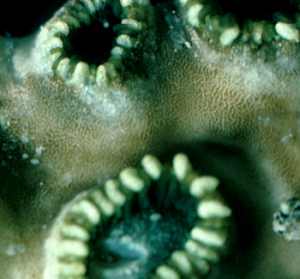

Feeding on Palythoa
PHOTO
Palythoa sp.. Upper photo showing fully extended polyps, and lower photo showing partially retracted polyps to five a view of the brown speckled appearance of the connective tissue. The brown colouration being the clusters of symbiotic zooxanthellae ingested by species of Aeolidiopsis. Lizard Island, Great Barrier Reef, June 1979. Photos: Bill Rudman.
Palythoa is a genus of colonial cnidarians [or coelenterates] belonging to the Order Zoanthidea. They are closely related to Sea Anemones and are best thought of as colonial sea anemones. Many tropical species have a symbiotic relationship with zooxanthellae and species of Palythoa incorporate sandgrains into the outer layers of their tissue. Three species of the aeolid genus Aeolidiopsis appear to feed exclusively on species of Palythoa. In fieldwork I have undertaken on the Great Barrier Reef, two colour forms of Palythoa were found, one predominantly greenish in colour, the other yellow brown. Unfortunately the state of the taxonomy of the zoantharians is such that it is impossible to discover if one or two species are involved. Specimens of Aeolidiopsis are associated only with the brown form.
A number of molluscan associates of Palythoa have been described (reviewed by Hadfield, 1976). Trench (1971) has shown that one species of Palythoa, P. townsleyi has a symbiotic relationship with zooxanthellae, and the large numbers of zooxanthellae in the epidermal tissues of the brown Palythoa on which Aeolidiopsis was found suggests that it also has a similar symbiosis. The individual polyps are connected by a thick coenochyme layer which has sand grains embedded in it. Zooxanthellae are found in all parts of the epidermis and some are also found in the gastrodermis lining the gut. The distribution of nematocysts is quite distinct and gives good evidence as to which part of the Palythoa colony the species of Aeolidiopsis feed on. The epithelium of the oral disc and inside of the tentacles is packed with small narrow nematocysts and spirocysts, probably associated with overpowering and capturing prey. On the outer side of the tentacles and the outer wall of the polyp the epithelium contains large nematocysts identical in structure to those in the cnidosacs of Aeolidiopsis ransoni and A. harrietae. From my observations, we know that the white form of A. ransoni burrows through the coenochyme layer connecting the polyps. The nematocysts in the cnidosacs of A. ransoni and in A. harrietae can only be obtained from the epidermis of the outer wall of the polyps and the connecting coenochyme. It is most probable that Aeolidiopsis feeds exclusively on this tissue. Zooxanthellae are also plentiful in this region and as in the alcyonarian-feeding genus Phyllodesmium, symbiotic zooxanthellae in Aeolidiopsis most surely come from the epithelium of the Palythoa colony.
See:
• photos of A. harrietae cnidosac.
• photo of A. ransoni cnidosac.
• page on solar powered opisthobranchs.
• A. ransoni - Biology and natural history.
• A. harrietae.
References:
• Hadfield, M.G. (1976) Mollusks associated with living tropical corals. Micronesica, 12(1): 133-148.
• Rudman, W.B. (1982) The taxonomy and biology of further aeolidacean and arminacean nudibranch molluscs with symbiotic zooxanthellae. Zoological Journal of the Linnean Society, 74: 147-196.
Rudman, W.B., 2002 (July 19) Feeding on Palythoa. [In] Sea Slug Forum. Australian Museum, Sydney. Available from http://www.seaslugforum.net/factsheet/palyfeed
Related messages
-
Re: Polyp-feeding nudibranch
From: erik, April 20, 2007 -
Aeolidiopsis sp. in aquarium
From: Scott Smith, March 13, 2007 -
Re: Polyp-feeding nudibranch
From: Jack Kryppy, November 7, 2006 -
Re: Polyp-feeding nudibranch
From: David Sherrer, October 27, 2006 -
Re: Perhaps a gorgonian feeder?
From: Leslie Harris, August 26, 2006 -
Re: Perhaps a gorgonian feeder?
From: Jon Humphreys, August 26, 2006 -
Perhaps a gorgonian feeder?
From: Jon Humphreys, August 25, 2006 -
Polyp-feeding nudibranch
From: Mark Johnson, December 7, 2002 -
Nudibranch or sea slug pest in my aquarium
From: ronman, October 29, 2002 -
Another Palythoa-feeding slug
From: Michael Mrutzek, October 17, 2002 -
Palythoa -feeding nudibranch
From: Michael Mrutzek, October 16, 2002
